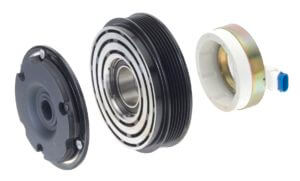Diagnose compressor clutch coil
Test compressor clutch coil
If your car’s AC compressor clutch won’t engage and low side and high side pressures are within specifications, test compressor clutch coil.
Using a DVOM set to the ohms scale, disconnect the electrical connector to the clutch coil. Touch the probes to the clutch coil terminals. Normal clutch coil resistance is 3Ω to 5Ω. Readings less than 2Ω or greater than 5Ω mean the clutch coil is bad.
Check operational voltage
With the engine running and AC in MAX

AC compressor clutch connector
position, set your DVOM to DC volts and backprobe the positive side of the clutch coil connector. Then backprobe the negative side of the connector. The reading should be within 1-volt of alternator output voltage.
If the voltage is much less, the coil can overheat, leading to failure.
Perform a voltage drop test on the clutch coil
Set your DVOM to DC volts. Connect one lead to battery post and the other lead to the positive terminal of the clutch coil connector. The voltage drop should be less than 1-volt. A higher readings means excessive resistance in the circuit between the battery and the compressor clutch.
Set your DVOM to DC volts. Connect one lead to battery NEGATIVE post and the other lead to the NEGATIVE terminal of the clutch coil connector. The voltage drop should be less than 0.2-volt. A higher readings means excessive resistance in ground circuit to the compressor clutch coil.
©. 2018 Rick Muscoplat
Posted on by Rick Muscoplat
